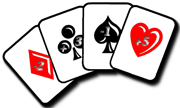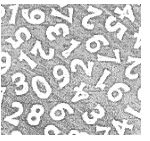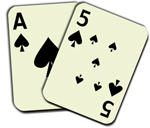 Card counting is one of the most famous strategies in blackjack, but is also one of the most misunderstood by people. It has not been accurately portrayed in movies, where card counting is shown as a way to make a lot of money through blackjack. We have been given the image that card counters can predict the card that follows and easily beat the casinos. It is also shown that only gifted people can card count, whether they are autistic like in Rain Man, or are math geniuses like in 21, who can calculate numbers just as fast as the dealer hands out the cards, all while keeping up with the hundred of cards being played.
Card counting is one of the most famous strategies in blackjack, but is also one of the most misunderstood by people. It has not been accurately portrayed in movies, where card counting is shown as a way to make a lot of money through blackjack. We have been given the image that card counters can predict the card that follows and easily beat the casinos. It is also shown that only gifted people can card count, whether they are autistic like in Rain Man, or are math geniuses like in 21, who can calculate numbers just as fast as the dealer hands out the cards, all while keeping up with the hundred of cards being played.
There are many fallacies that we need to clear up before moving forward. The truth is that card counting does not guarantee big wins in the short term. Alternatively, the strategy implemented with card counting allows players to have a slight advantage over the house, which is usually held by the casinos. Another truth is that you don’t have to be a genius to count cards. Most players can learn simple card counting systems with ease. For players willing to dedicate more time and effort, they can end up learning more complex card counting systems, and increase their edge over the house even further. As you can see, it does take a lot of work, and it is a strategy used to win more money in the long run; sorry, you won’t get rich quick, but you may still be able to get rich.
How Card Counting Works
 Most casino blackjack is dealt from a shoe, with six to eight decks being used. The cards are dealt in order, and until the shoe is nearly finished; they usually leave 25% of the cards in the shoe before they shuffle all cards. Being able to see and follow which cards have been dealt, we are able to guess which cards are still in the shoe.
Most casino blackjack is dealt from a shoe, with six to eight decks being used. The cards are dealt in order, and until the shoe is nearly finished; they usually leave 25% of the cards in the shoe before they shuffle all cards. Being able to see and follow which cards have been dealt, we are able to guess which cards are still in the shoe.
This can give the player two very important pieces of information. There are certain cards that are favorable for the player, as well as cards that favor the dealer. Higher value cards are generally better for the player, while smaller value cards are better for the dealer; knowing the hand rankings of the cards will be to your advantage. Aces and Tens are great for players, whereas Fives and Fours are good for the dealer.
The reason is that Aces and Tens allow players to take advantage of all the options they are given. For example, a player that gets more blackjacks, will get paid 3-2, while the dealer or the house will only receive the players bet if they get a blackjack. The player also has the advantage of being able to Stand on hands below 17, while the dealer has to hit until they reach 17 or more, and with more Tens in the shoe will more than likely make their hand bust more often. Additionally, players can also double down, where if they receive a Ten or an Ace, they will have a great hand. They can also take insurance if the shoe has enough tens, and can surrender if the dealer has a strong hand.
To sum things up, the player can perform much better when the shoe has a lot of tens and aces at their disposal. On the other hand, small value cards will prevent this. If a lot of small cards have already been dealt, the rest of the shoe is very favorable for the player.
Card counters are good at knowing what cards remain in the shoe in a few ways. Some card counters will take insurance based off of what cards remain in the shoe, and in extreme cases they will drift away from their basic strategy based on counting. The best method card counters improve their advantage is by placing bigger bets when the player has the advantage, and placing lower bets when the odds are in favor of the dealer; in some cases they will avoid playing altogether.
Challenges and Precautions of Card Counting
 Opposed to what most believe, card counting is actually not illegal. As long as players are not cheating or using devices to assist while they play, they are allowed to play their hand however they want, and that includes keeping a mental track of which cards have been dealt and alter their strategy.
Opposed to what most believe, card counting is actually not illegal. As long as players are not cheating or using devices to assist while they play, they are allowed to play their hand however they want, and that includes keeping a mental track of which cards have been dealt and alter their strategy.
This does not mean casinos will sit back and let players count cards easily. Casinos can always try to make conditions hard or impossible for card counters. For example, casinos can shuffle their cards more often, lowering the time a player has of tracking which cards have been dealt. At some casinos, after a few hands have been played, the cards are placed into an automatic shuffler and the dealer will simply continue playing from the shoe, where these cards are placed. If a casino knows that you are a blackjack card counter, they could even refuse service, as that is their right to do so.
This is one big challenge a player has when counting cards. They have to be able to keep track of all of the
One big precaution every card counter should know is to never underestimate the house edge. A good card counter can expect to make a profit and come out ahead of the casino, but will most likely occur in the long run. Using a card counting system can be as unpredictable as following a basic strategy; where both depend on the long run, and will show a lot of wins and losses in the short term.
Card Counting Systems
There are different card counting systems that players can learn:
- Ace-Five Counting Systems; a simple system, with many accredited like Edward Thorpe and Don Schlesinger.
- Hi-Lo Counting Systems
- Speed Count
- Unbalanced Counting Systems
- The Knock-Out Count/Derivative Systems
- Revere Counts System; thanks to Lawrence Revere.
- The Zen Count System
- Wong Halves System; thanks to Stanford Wong.
 These systems can range from simple to understand and learn, like Ace-Five and Hi-Lo, to very complex, like Wong Halves, but they all have similar components. For example, the cards are given certain values that players must remember as the shoe is being played. Cards that are favorable for the player are given Negative values, and cards that are favorable for the dealer are given Positive values. The number is divided by the estimated amount of decks still in the shoe, and this lets the player know how many favorable cards are still available.
These systems can range from simple to understand and learn, like Ace-Five and Hi-Lo, to very complex, like Wong Halves, but they all have similar components. For example, the cards are given certain values that players must remember as the shoe is being played. Cards that are favorable for the player are given Negative values, and cards that are favorable for the dealer are given Positive values. The number is divided by the estimated amount of decks still in the shoe, and this lets the player know how many favorable cards are still available.
Many counting systems will tell the player how to bet during any hand based on the true count, as well as when to take insurance. Sometimes, the count will let the player know when to alter their basic strategy and play differently. This can be based on the remaining cards and count of the shoe, indicating that the odds have changed in favor of a different play.
There are card counting systems that require that players keep a side count of the aces. The aces affect the game much more differently than the other cards, and players will want to place bigger bets when there are more aces; since the odds of a blackjack are higher. Even though aces have this advantage, Tens actually impact the game more. This is why you may find that some systems may keep the ace count separate from the total count.
What system should you choose? There are different advantages when picking a card counting system. The more complicated systems come with a higher reward, but also come with higher risk for the player. Complicated systems will require players to remember additional information, and could lead to making mistakes; with just a few mistakes could remove any advantage the player has. Pick a system that you are more comfortable with, being an expert at a simple system may be better than only just being a beginner at a complex system, even if the complex system offers more potential profit.
Ace-Five Counting Systems
 One of the easiest card counting system currently available is the Ace-Five count. Other systems that use this particular name share a common factor: they only count the Aces and Fives, and ignore the rest of the cards. This is due to the fact that Aces are the best card in the shoe for the player and Fives are the worst.
One of the easiest card counting system currently available is the Ace-Five count. Other systems that use this particular name share a common factor: they only count the Aces and Fives, and ignore the rest of the cards. This is due to the fact that Aces are the best card in the shoe for the player and Fives are the worst.
The concept is quite basic. Begin with a zero count. Every time a Five is dealt, add one to your count. Every time an Ace is dealt, subtract one from your count. The higher the count, the more advantage the player has.
Counting systems will vary on how the count affects your betting. A few will suggest changing your bet amount by a specific number of units, while others are more arbitrary and suggest doubling your bet when there is a point in your favor. What players need to keep in mind is that when the count goes in their favor, at least +2 or more, they should start betting more than the table minimum. As long as the count continues to grow or remain high, the player should bet more; keeping in mind that the player should only bet as much as they are comfortable with.
The Ace-Five counting systems don’t demand big changes in how you play, so simply use the basic strategy, while using bigger bets when the advantage is on your side to make you a winner. As the system is basic, it will give the player a slight advantage over the house; with the combination of casino comps and other perks, the blackjack games can become entertaining and profitable.
Blackjack Card Counting Summary
Before trying to learn any of the simple or complex counting systems, it is important for players to learn and fully understand the basic strategy. Card counting depends on being able to perfectly use basic strategy, as any errors will sabotage any advantage you had hoped to gain with card counting. Remember that becoming an expert on the basics is important before moving on to using advanced strategies, if you want to win.





